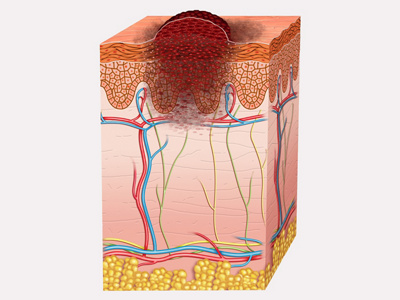Skin cancer is a type of cancer that has become more common in recent years. There are three different types: melanoma (‘black skin cancer’), basal cell carcinoma and spinalioma. The last two are also known as ‘white skin cancer’. Melanoma is the most dangerous type of skin cancer, because unlike the other types, it forms metastases in other organs.
- Black skin cancer
- White skin cancer
- Causes of skin cancer
- What are the signs of skin cancer?
- Diagnosis of skin cancer
- Treatment
- Prevention of skin cancer
Black skin cancer
Melanoma consists of pigment cells (melanocytes) in the skin. It is the most malignant form of skin cancer. Even at an early stage, melanoma can form tumours (metastases) in other organs. In rare cases, melanoma can also develop in mucous membranes. For example, in the mouth or genital area.
White skin cancer
The white or light types of skin cancer (spinalioma, basal cell carcinoma) consist of epithelial cells (keratinocytes) in the skin. Unlike melanoma, white skin cancers are usually localised and do not form any other tumours.
Causes of skin cancer
UV radiation is the main cause of all three types of skin cancer. That is why it is more commonly found on parts of the body frequently exposed to sunlight. In addition to natural UV radiation from the sun, artificial UV radiation from solariums are also a risk factor.
What are the signs of skin cancer?
Given that the appearance of skin cancer can vary greatly, every new mole or changes in existing moles should be examined by a doctor.
Special attention should be paid to the following warning signs:
- abnormal spots on the skin with irregular edges
- moles that itch
- pigmentations or lumps that bleed
- pigmentations that change in size and colour
Diagnosis of skin cancer
To ensure early detection, any skin change should be checked by a doctor. A tissue sample is taken from the suspicious mole or lump to make a diagnosis. However, with melanoma, additional diagnostic examinations are required to determine how far the disease has progressed and to identify possible metastases. This includes ultrasound examinations, computed tomography (CT), magnetic resonance imaging (MRI) and skeletal scintigraphy.
Treatment
If the doctor’s suspicion is confirmed, the skin cancer is surgically removed. This is usually sufficient to cure basal cell carcinomas and spinaliomas. The success of melanoma treatments depends on the cancer’s stage of development. If detected and treated early on, there is a good chance that melanoma will be cured by surgery. If metastases have already started to form, other treatment options can be used, for example radiotherapy and chemotherapy.
Prevention of skin cancer
People with a large number of moles should have them checked regularly (annually) by a dermatologist. The most important recommendations for preventing skin cancer also include:
- avoid getting sunburnt
- stay in the shade between 11:00 am and 3:00 pm
- wear a hat, sunglasses and clothing when exposed to very strong sunlight
- apply sunscreen
- avoid using solariums
Why choose Hirslanden
The specialists at Hirslanden, the largest private hospital group in Switzerland, are renowned for their expertise and many years of experience in treating your illness.
You can expect comfortable rooms and a modern infrastructure as well as the highest standards in medicine and care.
We will help you throughout your entire stay, organising additional services such as translators and interpreters, transport, and overnight hotel stays for you and your relatives, and addressing all your administrative questions.
A personal contact from the Hirslanden International team will take care of your needs from the time that you first contact us to arrange an appointment through to the end of your treatment.
Contact us – we are happy to help you!
How to check your moles using the ABCDE rule:

